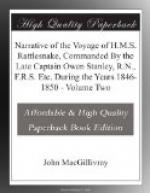(Footnote. They were beginning to run short of provisions, and the salt meat was so bad that the men preferred such RATS as they could catch. It even became necessary to prevent the crew from eating the LEATHER about the rigging and elsewhere in the ship.)
(**Footnote. Voyage autour du Monde par la Fregate du Roi La Boudeuse et la Flute l’Etoile en 1766 a 1769 page 258. See also the chart of the Louisiade given there, which, however, does not correspond very closely with the text.)
The Boudeuse and Etoile were engaged in working to windward along this new land (as it was thought to be) until the 26th, when, having doubled its eastern point, to which the significant name of Cape Deliverance was given, they were enabled to bear away to the North-North-East. The name of Gulf of the Louisiade was bestowed by Bougainville upon the whole of the space thus traversed by him, extending between Cape Deliverance and that portion of (what has since been determined to be) the coast of New Guinea of which he gives so glowing a description, and calls the Cul de Sac de l’Orangerie upon his chart.
CAPTAIN EDWARDS.
The next addition to our knowledge of these shores was made in August, 1791, by Captain Edwards in H.M.S. Pandora, shortly before the wreck of that vessel in Torres Strait, when returning from Tahiti with the mutineers of the Bounty. In the published narrative of that voyage the following brief account is given. “On the 23rd, saw land, which we supposed to be the Louisiade, a cape bearing north-east and by east. We called it Cape Rodney. Another contiguous to it was called Cape Hood: and a mountain between them, we named Mount Clarence. After passing Cape Hood, the land appears lower, and to trench away about north-west, forming a deep bay, and it may be doubted whether it joins New Guinea or not."* The positions assigned to two of these places, which subsequent experience has shown it is difficult to identify, are:




